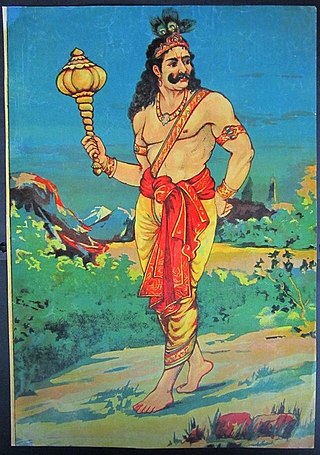
In the Hindu epic Mahabharata, Bhima is the second among the five Pandavas. The Mahabharata relates many events that portray the might of the hero Bhima. Bhima was born when Vayu, the wind god, granted a son to Kunti and Pandu. After the death of Pandu, Kunti with her sons stayed in Hastinapura. From his childhood, Bhima had a rivalry with his cousins Kauravas, especially Duryodhana. Duryodhana and his uncle, Shakuni, tried to kill Bhima multiple times. One was by poisoning and throwing Bhima into a river. Bhima was rescued by Nāgas and was given a drink which made him very strong and immune to all venom.
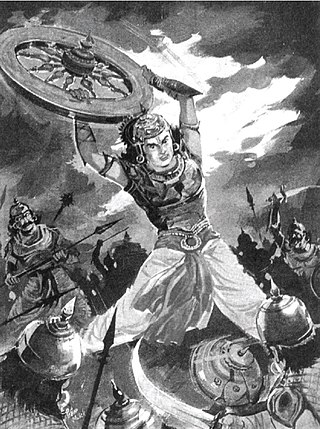
Abhimanyu is a warrior in the Hindu epic Mahabharata. He was the son of Arjuna and Subhadra, and was married to Uttarā. Abhimanyu is portrayed as a young, strong and talented warrior. He was also one of the few individuals, along with his father, who knew the technique to enter the Chakravyuha, a powerful military formation.
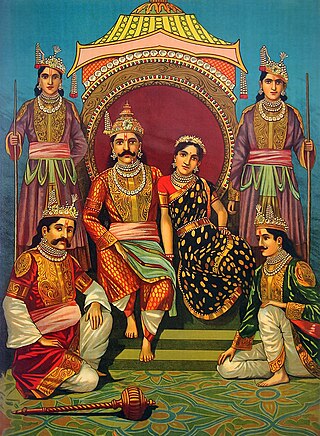
Yudhishthira also known as Dharmaraja, was the king of Indraprastha and later the King of Kuru Kingdom in the epic Mahabharata. He is the eldest among the five Pandavas, and is also one of the central characters of the epic.
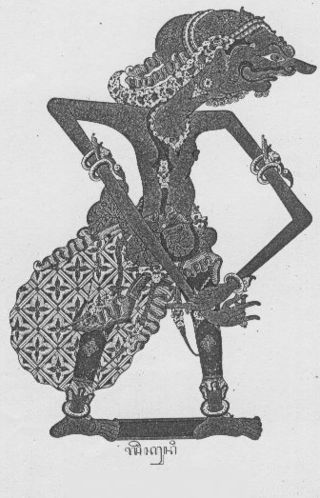
Shakuni is one of the antagonists of the Hindu epic Mahabharata. He was the prince of the kingdom of Gandhara when introduced, later becoming its king after the death of his father, Subala. He was the brother of Gandhari and the maternal uncle of the Kauravas.

Kripa, also known as Kripacharya, is a figure in Hindu mythology. According to the epic Mahabharata, he was a council member of Kuru Kingdom and a teacher of the Pandava and Kaurava princes.

The Harivamsa is an important work of Sanskrit literature, containing 16,374 shlokas, mostly in the anustubh metre. The text is also known as the Harivamsa Purana. This text is believed to be a khila to the Mahabharata and is traditionally ascribed to Vyasa. The most celebrated commentary of the Mahabharata by Neelakantha Chaturdhara, the Bharata Bhava Deepa also covers the Harivamsa. According to a traditional version of the Mahabharata, the Harivamsa is divided into two parvas (books) and 12,000 verses. These are included with the eighteen parvas of the Mahabharata. The Critical Edition has three parvas and 5,965 verses.
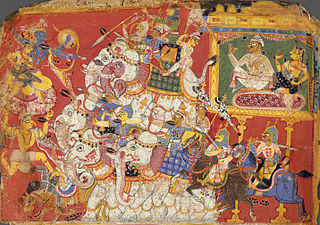
Bhagadatta was the son of Narakasura, and the king of Pragjyotisha in Hindu mythology. Bhagadatta was born from a limb of the asura called Bashkala. He was a renowned warrior, and was known to be a great friend of Indra. When Arjuna embarked on a conquest to help his brother Yudhishthira perform the rajasuya yajna, Bhagadatta was one of the first kings to be conquered by him.
The Adi Parva or The Book of the Beginning is the first of eighteen books of the Mahabharata. "Ādi" in Sanskrit means "first".
Sabha Parva, also called the "Book of the Assembly Hall", is the second of eighteen books of Mahabharata. Sabha Parva traditionally has 10 parts and 81 chapters. The critical edition of Sabha Parva has 9 parts and 72 chapters.
The Vana Parva, also known as the "Book of the Forest", is the third of eighteen parvas in the Indian epic Mahabharata. Vana Parva traditionally has 21 parts and 324 chapters. The critical edition of Vana Parva is the longest of the 18 books in the epic, containing 16 parts and 299 chapters.
Virata Parva, also known as the “Book of Virata”, is the fourth of eighteen books of the Indian epic Mahabharata. Virata Parva traditionally has 4 parts and 72 chapters. The critical edition of Virata Parva has 4 parts and 67 chapters.
The Shalya Parva, or the Book of Shalya, is the ninth of eighteen books of the Indian epic Mahabharata. Shalya Parva traditionally has 4 parts and 65 chapters. The critical edition of Shalya Parva has 4 parts and 64 chapters.
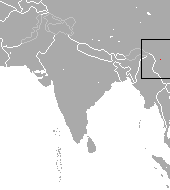
The pygmy brown-toothed shrew is a species of shrew in the order Eulipotyphla. It is distributed in China. C. parva was initially thought to be the same as Chodsigoa lamula, but it was found to be a separate species.
Anushasana Parva or the "Book of Instructions", is the thirteenth of eighteen books of the Indian epic Mahabharata. It traditionally has 2 parts and 168 chapters. The critical edition has 2 parts and 154 chapters. Sometimes this parva is referred to as the "Book of Precepts".
The Stri Parva, or the "Book of the Women," is the eleventh of eighteen books of the Indian epic Mahabharata. It traditionally has 4 parts and 27 chapters, as does the critical edition.
Drycothaea is a genus of longhorn beetles of the subfamily Lamiinae.
Drycothaea rotundicollis is a species of beetle in the family Cerambycidae. It was described by Galileo and Martins in 2010. It is known from Costa Rica.
Drycothaea angustifrons is a species of beetle in the family Cerambycidae. It was described by Breuning in 1943. It is known from French Guiana and Ecuador.
Drycothaea brasiliensis is a species of beetle in the family Cerambycidae. It was described by Breuning in 1974. It is known from Brazil and French Guiana.
Drycothaea truncatipennis is a species of beetle in the family Cerambycidae. It was described by Tavakilian in 1997. It is known from Brazil.







